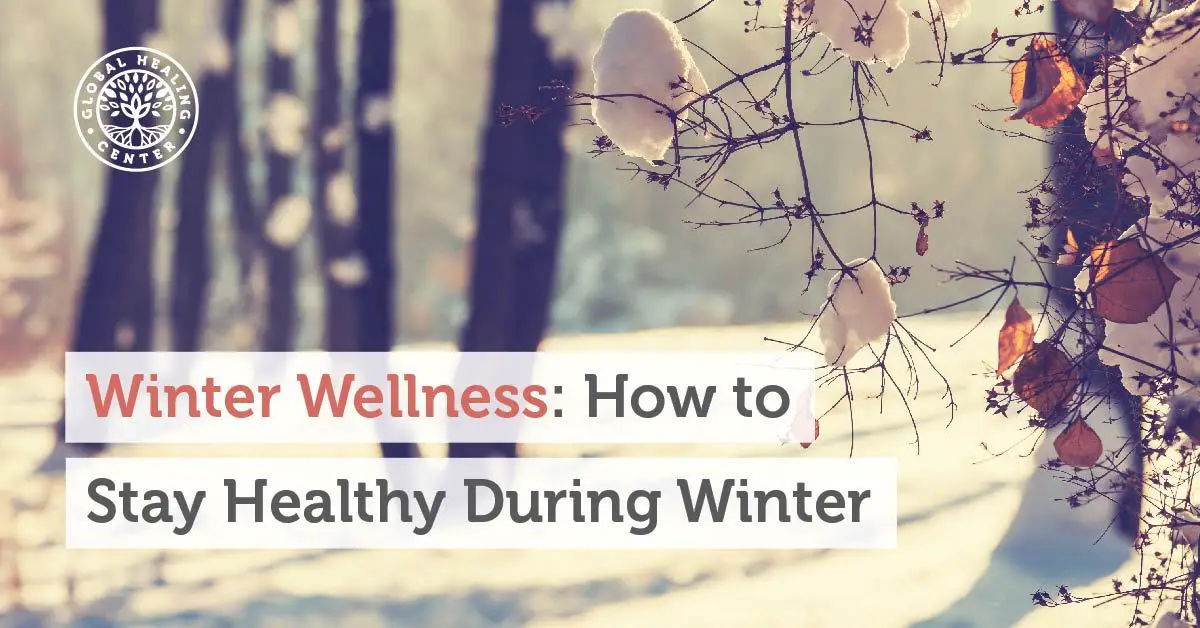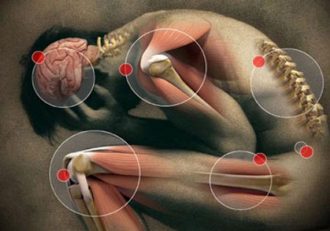Guest writer for Wake Up World
Winter is a busy, festive time of year. It’s also a time when more people tend to get sick. What exactly is it about this time of year that encourages aches and sniffles? “Catching a chill” has long been suspected as a cause of winter ailments and, for just as long, has been dismissed as folklore.
Can You Get Sick from Cold Weather?
It is true that exposure to cold temperatures constricts blood vessels and reduces blood flow. Conceivably, this could weaken the immune system since it means fewer protective white blood cells make the rounds.[1] But cold weather alone will not make you sick. Harmful bacteria and viruses are to blame, although some are easier to catch and spread during cold, dry weather.[2, 3]
Human behavior is more responsible for the transmission of illness than cold weather. Human behavior facilitates the transmission of the common cold and flu. During the winter, we travel en masse and stay indoors, in close contact with our friends and families. As a result, common winter concerns such as a cold, sore throat, asthma, stiff joints, cold sores, dry skin, and the flu are simply easier to catch.[4]
Common Winter Health Concerns
Seasonal ailments are many and diverse. Let’s look at a few of the most common and their symptoms and causes.
The Cold
The common cold affects millions of people. In fact, the average adult will catch it at least two or three times per year.[5] Colds are caused by viral infections, and the most common are human rhinoviruses, or HRVs.[6] They result in upper respiratory infections with symptoms like a runny nose, sore throat, cough, headache, or mild body aches.[7]
Sore Throat
A sore throat, par for the course during the winter, is usually an early sign of an upper respiratory infection.[8]
Asthma
Asthma isn’t a seasonal ailment but asthma can be exacerbated by the cold, especially a sudden drop in temperature (such as when you step outside during the dead of winter). Additionally, an asthma attack, which can cause coughing, wheezing, and shortness of breath,[9] can be brought on by other conditions, such as a cold or flu.[10]
Norovirus
Norovirus is a contagious gastrointestinal illness that can cause nausea, projectile vomiting, and watery stool. It’s especially troublesome in densely populated buildings like schools, hospitals, nursing homes, and cruise ships. Touching contaminated surfaces (like counters or doorknobs), eating food that’s been handled by an infected person, or even inhaling viral particles can spread the virus.[11]
Painful Joints
The relationship between stiff, sore joints and cold weather is a strange one. It seems counterintuitive that cold weather would exacerbate inflammation, but a sudden drop in temperature is usually preceded by a drop in barometric pressure. People with inflamed joints are more attuned to changes in atmospheric pressure and may feel more pain in injured areas. Stiff joints might also hurt more in the winter because people are more sedentary when it’s cold outside.[12]
Cold Sores
Cold sores are the result of the highly contagious HSV-1 virus. The virus remains dormant in the body’s nerve cells until activated. Many factors, including stress or a compromised immune system, can trigger an outbreak. To prevent transmission to other people or parts of the body, avoid touching cold sores, don’t share food or utensils, and wash your hands frequently.[13]
Dry Skin
In many places, the humidity drops during the winter; less moisture in the air can lead to dry skin. Don’t use harsh, drying soaps or bathe in water that’s too hot–both can dry your skin. Moisturize your skin by applying a rich lotion after showering. You can also invest in a humidifier for your bedroom.
The Flu
Flu symptoms and cold symptoms are similar but flu symptoms are more severe and include fever, chills, body aches. If it escalates, the flu can lead to more serious health problems like pneumonia; it can even become life-threatening.[14] It’s important to be especially vigilant since you can catch the flu from up to 6 feet away by droplet transmission. Infected people are usually contagious for a day before symptoms appear and up to 7 days after.[15]
If you get sick, stay home.[16] Stay hydrated, get a lot of rest, and let yourself recuperate, don’t spread it around your workplace. You’re not at your best when you’re sick, and you can greatly hinder productivity[17] even further by getting your coworkers sick.
Winter Allergies
For many people, winter time means spending more time indoors… with the mold spores, pet dander, chemical cleaners, and dust mites. When you consider that most homes are sealed up tight and ventilation is lacking, it’s no surprise that allergies can flare up during the winter months.[18]
How to Avoid Getting Sick
Prevention is the best strategy for avoiding winter bugs. The following are tips for protecting yourself and keeping your immune system strong.
Follow a Healthy Diet
Eating poorly can significantly affect your health by changing the composition of your gut microbiome, leaving you open to attack from harmful bacteria. Conversely, consuming lactic acid bacteria naturally found in raw food like fruits and vegetables supports gut health.[19] Probiotics like lactobacilli support normal respiratory health.[20][21]
Many of the traditional, seasonal comfort foods offer little nutritional value. Studies show that concentrated glucose consumption without antioxidants causes oxidative stress in the blood[22] and puts you in a pro-oxidative state,[23] which compromises your immune defenses.[24] Combat the effect by eating plenty of leafy greens, beans, and citrus.
Exercise and Stay Active
When it’s cold and the days are short, working out might be the last thing you feel like doing, but exercise supports the immune system and may actually prevent you from getting sick. Aerobic exercise helps circulate white blood cells throughout your body so they can find and fight harmful microbes. Exercise lowers stress hormones[25] and combats seasonal affective disorder.[26]
Manage Your Stress
Stress is inevitable, and occasional stress is actually good for you.[27] But, prolonged stress weakens the immune system.[28] One of the many effects of stress is a shrunken, atrophied thymus. The thymus is the small organ in the lymphatic system that makes T-cells,[29] which are highly specialized immune cells that target specific types and strains of microbes, like viruses.
Control your stress levels and mitigate your stressors to support your immune system. Make time for yourself and avoid over-committing to social engagements. Sometimes it’s difficult to say “no” but rest and recuperation is essential for strong immune defenses.
Sleep Well
A lack of sleep affects the immune system and consistent sleep deprivation causes the body to enter a pro-inflammatory state – in as few as 8 days.[30] Because immune cells are most active during the sleep cycle, a good night’s rest is essential. If you feel you’re coming down with something, get some rest–it strengthens the immune response.[31]
Protect Your Skin
Skin can be especially sensitive to extreme temperatures. Bathing and showering in hot water can make dry skin worse, even prone to cracking.[34] Cold, dry air wreaks havoc on skin, too.[35] Moisturize your skin by applying organic skin care lotion immediately after getting out of the shower.
Gargle
Gargling is a great way to prevent yourself from getting sick. Though it’s great for soothing a sore throat, it turns out that gargling salt water is an effective way to discourage upper respiratory infections.[36] You can even try gargling green tea. According to one study, gargling with green tea is more effective than plain water at preventing fevers in children.[37]
Stay Warm
Exposure to cold weather causes vasoconstriction. Dress appropriately for the weather and keep the immune defenses in your air passages strong and well supplied with white blood cells.
Wash Your Hands
Regular hand washing is one of the best ways to prevent sharing infections. Shared surfaces like handrails, doorknobs, and elevator buttons are an obvious conduit for pathogens; we then unknowingly infect ourselves when we touch our faces.[32] Most people touch their face an average of 4 times an hour, and they touch shared surfaces about 3 times an hour. So wash your hands after touching shared surfaces.[33]
Keep these tips in mind to keep your immune system strong this winter. Have yourself some happy healthy holidays!
References: see below.
Related reading:
- Considering the Flu Shot? Here Are Five Reasons to Think Twice
- Kick Influenza and Colds to the Curb with Garlic
About the author:
 Dr. Edward F. Group III (DC, ND, DACBN, DCBCN, DABFM) founded Global Healing Center in 1998 and is currently the Chief Executive Officer. Heading up the research and development team, Dr. Group assumes a hands-on approach in producing new and advanced degenerative disease products and information.
Dr. Edward F. Group III (DC, ND, DACBN, DCBCN, DABFM) founded Global Healing Center in 1998 and is currently the Chief Executive Officer. Heading up the research and development team, Dr. Group assumes a hands-on approach in producing new and advanced degenerative disease products and information.
Dr. Group has studied natural healing methods for over 20 years and now teaches individuals and practitioners all around the world. He no longer sees patients but solely concentrates on spreading the word of health and wellness to the global community. Under his leadership, Global Healing Center, Inc. has earned recognition as one of the largest alternative, natural and organic health resources on the internet.
For more information, please visit Global Healing Center.
Recommended articles by Dr. Edward Group:
- The Benefits of Apple Cider Vinegar
- The 9 Best Fermented Foods for Your Gut
- 14 Foods that Cleanse the Liver
- Top 5 Foods for the Pineal Gland
- 6 Things You Must Know About Colloidal Silver
- The Importance of a Kidney Cleansing Diet
- The 9 Best Herbs for Lung Cleansing and Respiratory Support
- 7 Best Foods to Support Kidney Function
- Lung Cleansing With Peppermint Oil
- How Fluoride Damages Pineal Gland Health
- The Top 20 GMO Foods and Ingredients to Avoid – and Why
- How Does the Alkaline Diet Affect Gut Health?
- 15 Best Essential Oils and Their Health Benefits
References:
- Eccles, R. Acute Cooling of the Body Surface and the Common Cold*. Cardiff University, United Kingdom: n.p., 2002. Web. 21 Nov. 2016.
- “Flu Virus Fortified In Colder Weather.” National Institutes of HEALTH. National Institutes of Health (NIH), 30 Mar. 2016. WEB. 21 Nov. 2016.
- Becker, R A, Carl Zimmer, and Allison Eck. “Scientists Finally Prove Why Cold Weather Makes You Sick.” PBS. NOVA Next, 12 Jan. 2015. Web. 21 Nov. 2016.
- Choices, NHS. 10 winter illnesses. Department of Health, 30 Sept. 2016. Web. 21 Nov. 2016.
- CDC. “Common Colds: Protect Yourself and Others.” Centers for Disease Control. CDC, 8 Feb. 2016. Web. 21 Nov. 2016.
- Ikäheimo, Tiina M, et al. “A Decrease in Temperature and Humidity Precedes Human Rhinovirus Infections in a Cold Climate.” Viruses 8.9 (2016): 244. Web. 21 Nov. 2016.
- CDC. “Common Cold and Runny Nose.” Centers for Disease Control. CDC, 16 Mar. 2016. Web. 21 Nov. 2016.
- “Understanding the symptoms of the common cold and influenza.” The Lancet: Infectious Diseases. Nov. 2005. Web. 21 Nov. 2016.
- “Asthma.” Medline Plus M. 1 Nov. 2016. Web. 21 Nov. 2016.
- CDC. “Common Asthma Triggers.” Centers for Disease Control. CDC, 20 Aug. 2012. Web. 21 Nov. 2016.
- “Norovirus.” National Health Institute. Department of Health, 30 Sept. 2016. Web. 21 Nov. 2016.
- “Weather Related Arthritis Symptoms: Medical Fact or Fiction?” N.p.: University of South Carolina School of Medicine, 2010. Web. 21 Nov. 2016.
- “Cold and Canker Sores.” University of Michigan. 2016. Web. 21 Nov. 2016.
- CDC. “Cold Versus Flu.” Centers for Disease Control. CDC, 11 Aug. 2016. Web. 21 Nov. 2016.
- “How Flu Spreads.” Centers of Disease Control. CDC, 12 Sept. 2013. Web. 21 Nov. 2016.
- “Cover your cough.” Centers for Disease Control and Prevention. CDC, 14 Aug. 2015. Web. 21 Nov. 2016.
- “CDC Flu Infographic.” CDC Foundation. 1962. Web. 21 Nov. 2016.
- “Ten Tips to Tackle Winter Allergies – Columbia University Medical Center.” Columbia University: Public Health. Columbia University Medical Center, 6 Dec. 2013. Web. 21 Nov. 2016.
- Vitali, B, et al. “Novel Probiotic Candidates for Humans Isolated from Raw Fruits and Vegetables.” Food microbiology. 31.1 (2012): 116–25. Web. 21 Nov. 2016.
- Hao, Q, et al. “Probiotics for Preventing Acute Upper Respiratory Tract Infections.”The Cochrane database of systematic reviews. (2011): n.pag. Web. 21 Nov. 2016.
- Berggren, A, et al. “Randomised, Double-Blind and Placebo-Controlled Study Using New Probiotic Lactobacilli for Strengthening the Body Immune Defence Against Viral Infections.” European Journal of Nutrition 50.3 (2010): 203–10. Web. 21 Nov. 2016.
- Mohanty, P, et al. “Glucose Challenge Stimulates Reactive Oxygen Species (ROS) Generation by Leucocytes.” The Journal of Clinical Endocrinology and Metabolism. 85.8 (2000): 2970–3. Web. 21 Nov. 2016.
- Prior, RL, et al. “Plasma Antioxidant Capacity Changes Following a Meal as a Measure of the Ability of a Food to Alter in Vivo Antioxidant Status.” Journal of the American College of Nutrition. 26.2 (2007): 170–81. Web. 21 Nov. 2016.
- Evans, Patricia, Barry Halliwell, and National. “Micronutrients: Oxidant/antioxidant Status.” British Journal of Nutrition 85.S2 (2001): 67–74. Web. 21 Nov. 2016.
- “Exercise and immunity.” Medline Plus. 1 Nov. 2016. Web. 21 Nov. 2016.
- “Seasonal Affective disorder.” Medline Plus. National Library of Medicine, 12 Oct. 2016. Web. 21 Nov. 2016.
- “Stress.” Medline Plus. National Library of Medicine, 15 Nov. 2016. Web. 21 Nov. 2016.
- Segerstrom, Suzanne C., and Gregory E. Miller. “Psychological Stress and the Human Immune System: A Meta-Analytic Study of 30 Years of Inquiry.” Psychological Bulletin 130.4 (2004): 601–603. Web. 21 Nov. 2016.
- Herman, James P. “Neural Control of Chronic Stress Adaptation.” Frontiers in Behavioral Neuroscience 7. (2013): n.pag. Web.
- Besedovsky, Luciana, Tanja Lange, and Jan Born. “Sleep and Immune Function.”463.1 (2011): 121–137. Web. 21 Nov. 2016.
- “Sleep and Immune Function.” Pflugers Archive 463.1 (2011): 121–137. Web. 21 Nov. 2016.
- “When & How to Wash Your Hands.” Centers for Disease Control. CDC, 4 Sept. 2015. Web. 21 Nov. 2016.
- Rowan, Karen. “Stop Touching Yourself, Flu Researchers Say.” LiveScience. 28 Nov. 2012. Web. 21 Nov. 2016.
- “Dry skin—self care.” Medline Plus. 2015. Web. 21 Nov. 2016.
- Brebner, D. F., D. McK. Kerslake, and J. L. Waddell. “The Diffusion of Water Vapour Through Human Skin.” The Journal of Physiology 132.1 (1956): 225–231. Web.
- Satomura, K, et al. “Prevention of Upper Respiratory Tract Infections by Gargling: A Randomized Trial.” American Journal of Preventative Medicine 29.4 (2005): 302–307. Web. 21 Nov. 2016.
- Noda, T, et al. “Gargling for Oral Hygiene and the Development of Fever in Childhood: A Population Study in Japan.” Journal of epidemiology. 22.1 (2011): 45–9. Web,. 21 Nov. 2016.

If you've ever found value in our articles, we'd greatly appreciate your support by purchasing Mindful Meditation Techniques for Kids - A Practical Guide for Adults to Empower Kids with the Gift of Inner Peace and Resilience for Life.
In the spirit of mindfulness, we encourage you to choose the paperback version. Delve into its pages away from screen glare and notifications, allowing yourself to fully immerse in the transformative practices within. The physical book enriches the learning process and serves as a tangible commitment to mindfulness, easily shared among family and friends.
Over the past few years, Wake Up World has faced significant online censorship, impacting our financial ability to stay online. Instead of soliciting donations, we're exploring win-win solutions with our readers to remain financially viable. Moving into book publishing, we hope to secure ongoing funds to continue our mission. With over 8,500 articles published in the past 13 years, we are committed to keeping our content free and accessible to everyone, without resorting to a paywall.










